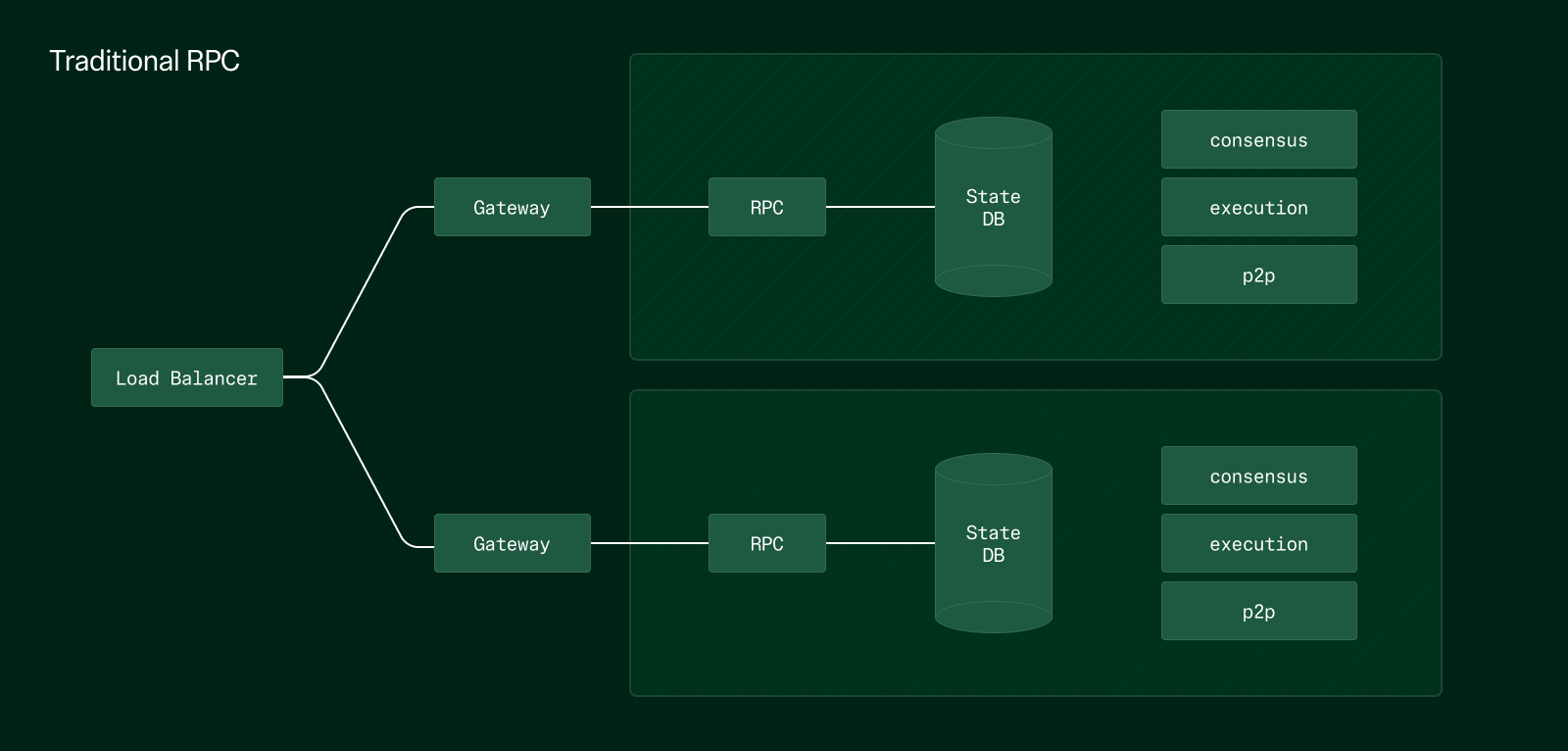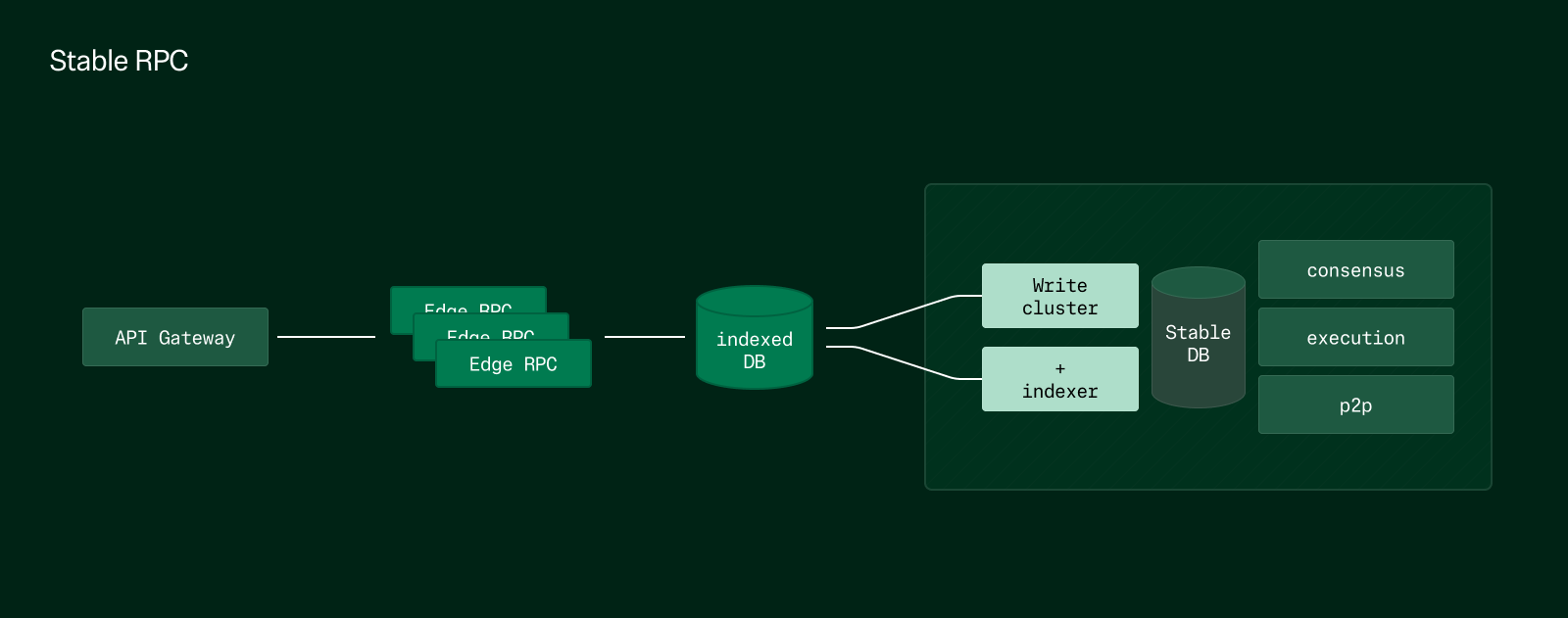Skip to main contentIn the pursuit of a high-performance blockchain, it’s not enough to only optimize consensus or block production. The RPC layer is a critical component of the end-to-end user experience because it is the interface between the blockchain and its users. Stable proposes a new RPC-dedicated architecture to overcome the limitations of traditional RPC design.
The User’s Gateway to the Blockchain
The Remote Procedure Call (RPC) interface is the primary way users interact with the blockchain:
- Wallets use RPC to broadcast transactions.
- DApps query state via RPC to render UI with on-chain data, to prepare and simulate transactions, fetch logs and events, etc.
- Explorers, indexers, and bots all rely on RPC for real-time data.
Even if the blockchain can process transactions at lightning speed and produce blocks rapidly, none of it matters if users experience latency and delays due to a slow RPC. In practice, we often find that RPC is the bottleneck in the overall user experience.
Stable’s roadmap toward a high-performance chain explicitly includes RPC optimization as a first-class priority.
The Problem with Traditional RPC Architecture
Monolithic Design and Resource Contention
 Traditionally, an RPC node is simply a repurposed full node with additional RPC endpoints exposed. This means:
Traditionally, an RPC node is simply a repurposed full node with additional RPC endpoints exposed. This means:
- Syncing the chain and serving RPC requests occur on the same instance.
- To scale RPC, teams must spin up entire new full nodes, triggering resource-heavy operations like state sync and consensus setup.
- Consensus, execution, and RPC all share the same CPU, memory, and disk. For example, during a period of high transaction load, if one component is busy, it starves the others, leading to degraded RPC performance.
In addition, traditional RPC architecture treats read-heavy and write-heavy operations in the same architecture. Even though read queries (e.g., eth_getBalance) vastly outnumber write transactions, there is no differentiation in how they are handled. This architecture is inherently inefficient and non-scalable.
The Stable RPC Architecture
Stable introduces a split-path RPC architecture that separates reads from writes and optimizes each independently.

Core Principles
- Separate the RPC into efficient lightweight RPC nodes based on functionality.
- Use lightweight RPCs as edge nodes to enhance scalability.
- Optimize the data path of function-specific RPCs to reduce latency, offering more direct access or management through more efficient data structures
Internal benchmarks of the new read RPC path demonstrate:
- Supports throughput of over 10,000 RPS, with end-to-end latency under 100ms in the same environment.
- Linear scalability of edge nodes, with no need for full state sync or consensus overhead.
Stable’s new RPC architecture results in a significantly smoother and faster user experience, even during high traffic events.
Future Work
Optimizing EVM View Calls
One exciting area of ongoing research is dedicated support for EVM view operations (eth_call):
- These do not require transaction commitment or state updates.
- Execution can happen on lightweight stateless environments using only the current state snapshot.
- A specialized RPC node could be designed specifically for these operations, delivering even faster response times and reducing load on primary full nodes.
Integration of Indexer Directly to the Node
By integrating an indexer directly into the node, it becomes possible to serve the fastest possible data to dApps.
- Typical architectures: Node → RPC → Indexer (e.g., The Graph) → Storage → dApp
- Proposed Architecture: Node with Indexer → DB → dApp
- This architecture enables much faster data delivery as the indexer is natively integrated into the node, removing the network communication steps.



